Western - Genres
Characteristics of the western
The western is a classic fiction genre that is considered one of the oldest in cinema. While the emergence of other genres is usually associated with the beginnings of European cinema, the emergence of the film western is exceptionally attributed to American cinema. Westerns are typically set in the old American West, also known as the Wild West, most often representing the second half of the 19th century, i.e. a time defined by the American Civil War, the Gold Rush, the gradual settlement of American land, the building of the railroad, battles with Indians, and other armed conflicts.
Usual characters are cowboys and gunslingers, who ride horses and wear leather suits and vests, wide hats, high riding boots with spurs, scarves around their necks and sometimes ponchos. The side of good is often represented by a sheriff or other defender of justice, while evil is represented by bandits and other law-breaking criminals. In addition to these, westerns often feature Native Americans, people of Latin American descent, American soldiers, and a host of townspeople representing, among other things, farmers, cattlemen and ranchers, fur trappers, gamblers, and bounty hunters.
A common location for most westerns is a small desert town or settlement with a jail, a saloon with live music and a bartender pouring liquor, and a main street where gunfights and gun duels can take place. Other buildings can be a hotel and a cabaret/brothel, a railway station, a church, a bank, a school or a grocery store. The surrounding landscape is complemented by vast prairies and treacherous desert or mountain scenery, Indian villages, farms, cattle ranches and forts.
Westerns of the silent era
Western themes existed in American entertainment culture even before the invention of the motion picture in 1895, with stories from the Wild West performed by traveling theatre companies in earlier times, and there were also pulp novels that told the stories of Billy Kid, Kalamity Jane and Wyatt Earp. Western elements penetrated cinema already in its early beginnings - for example, in a fifty-second film called Cripple Creek Bar-Room Scene (1899), co-written by the famous Thomas Edison, there were characters of a barmaid, drunks and gamblers. However, the first full-fledged western in cinema history is considered to be the ten-minute American film The Great Train Robbery from 1903, which stood out with its elaborate plot involving a train robbery and the hunt for the robbers that followed it.
Westerns were hugely popular in the silent film era and some of them launched the careers of leading men such as Tom Mix and William S. Hart. At that time, not only the famous directors like Cecil B. DeMille (The Squaw Man, 1914) and D.W. Griffith (The Battle at Elderbush Gulch, 1913) were making westerns, but also relative newcomers, such as the then little-known John Ford (The Iron Horse, 1924) and James Cruze, whose The Covered Wagon (1923) became a great success and led to an increase in the production of westerns in Hollywood. After the advent of the sound film in 1927-28, however, the major film studios put the genre on the back burner, and in the 1930s, smaller studios produced countless cheap and lowbrow westerns, made on very limited budgets.
The Great Train Robbery (1903)
Photo © Edison Manufacturing Company
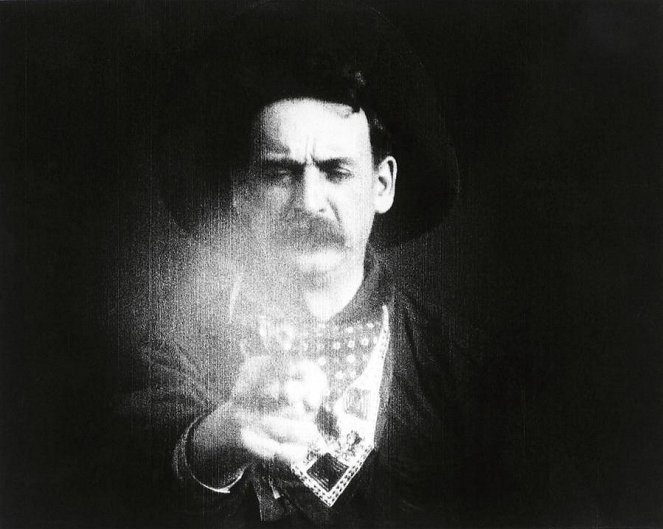
The breakthrough year of 1939 and the arrival of John Ford
The popularity of the genre did not increase significantly until 1939, when several major studios surprisingly came out with a number of generously financed westerns, all of which premiered that year. The first was 20th Century Fox's biographical western Jesse James, followed by Warner Bros.' Dodge City and Paramount Pictures' Union Pacific, directed by Cecil B. DeMille. In the same year, Universal Pictures released George Marshall's seminal film Destry Rides Again, starring James Stewart and Marlene Dietrich. It was preceded by the even more essential Stagecoach, directed by John Ford for United Artists, which elevated the western genre to an artistic level, confirmed Ford's reputation as one of the most important western directors of all time, and made a star out of the actor John Wayne, who until then had been virtually an unknown protagonist in films of poor quality.
In his films, John Ford created an original and clearly defined world that portrayed America in a romantic light as a land shrouded in myth, where brave men defended the lives of women and children from danger. In this vein, his work culminated in The Searchers (1956), voted by the American Film Institute as the best western of all time, in which the protagonist, an embittered officer played by John Wayne, sets out to find his niece, who has been kidnapped by Indians. Ford's other notable credits include My Darling Clementine with Henry Fonda (1946), The Man Who Shot Liberty Valance (1962), and Cheyenne Autumn (1964), as well as a cavalry trilogy consisting of Fort Apache (1948), She Wore a Yellow Ribbon (1949), and Rio Grande (1950).
Stagecoach (1939)
Photo © United Artists
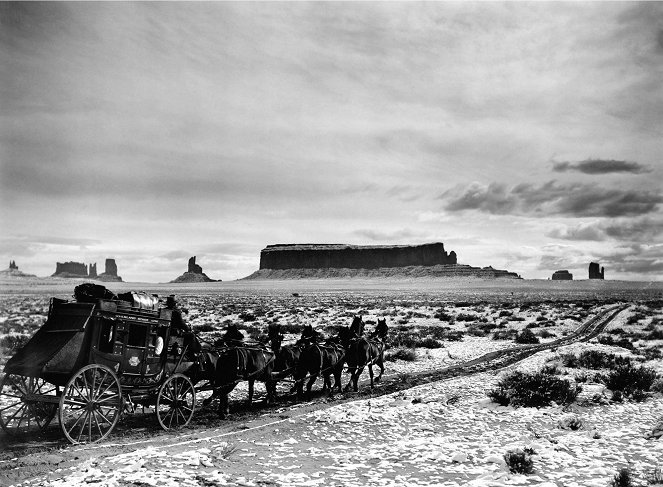
The golden age and subsequent decline of the American western
The enormous popularity of westerns lasted throughout the 1940s and peaked in the 1950s, when they eclipsed all other genres produced in Hollywood. Hungarian-born filmmaker Michael Curtiz directed Virginia City (1940) and Santa Fe Trail (1940), both starring Errol Flynn. German-born director Fritz Lang made Rancho Notorious (1952) and American filmmaker Howard Hawks cast John Wayne in his films Red River (1948), Rio Bravo (1959), El Dorado (1966) and Rio Lobo (1970). Director Anthony Mann often cast James Stewart, with whom he made, among others, Bend of the River (1952), The Naked Spur (1953), The Far Country (1954) and The Man from Laramie (1955), and he would also direct the westerns Devil's Doorway (1950) and The Tin Star (1957). In 1960, John Sturges' The Magnificent Seven premiered as an admitted remake of Japanese director Akira Kurosawa's epic Seven Samurai (1954). This famous western, which starred Eli Wallach, Steve McQueen, Yul Brynner and Charles Bronson, among others, was so successful that received three sequels in 1966-72.
Other highly regarded and popular westerns of this period include Henry King's The Gunfighter (1950), Fred Zinnemann's existential and philosophical western High Noon (1952), which won four Academy Awards, and William Wyler's The Big Country (1958). There were hundreds of Westerns made in Hollywood in the 1940s and 50s, a trend that was disrupted only in the 1960s, during which their number dropped to about a quarter. This was due, firstly, to the rise of television and the increasing number of western series produced specifically for the medium, secondly, to the sudden popularity of Italian spaghetti westerns, and thirdly, to a change of mindset in society towards greater tolerance in which some western motifs and ideas seemed outdated.
High Noon (1952)
Photo © 1952 Stanley Kramer Productions
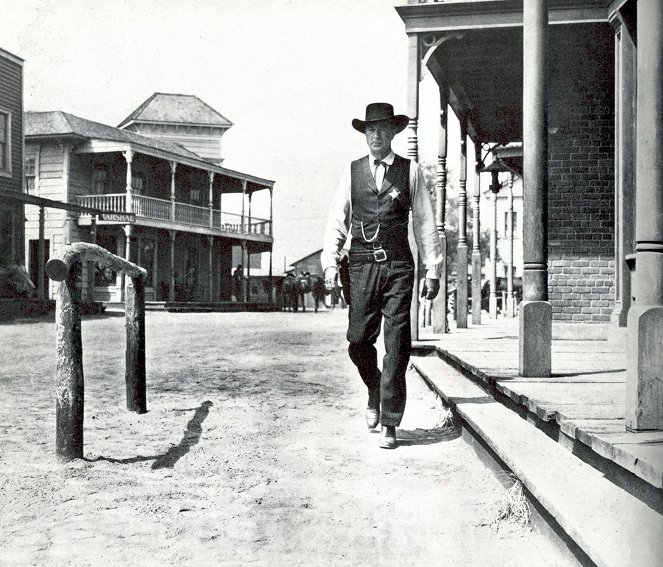
Spaghetti western and Sergio Leone
"Spaghetti western" or "Italian Western" were originally used as derisive terms for westerns produced mainly in the 1960s by Italian studios, often in collaboration with Spain, France and Germany. American opponents of this trend did not believe that European studios would be able to successfully imitate a genre that until then had been considered purely American. Spaghetti westerns were characterised by simplicity (simple and straightforward plots, nondescript and often even nameless protagonists) and a higher level of action and violence than American westerns. They were often made on very low budgets and usually filmed in arid parts of Spain or other locations that posed very little financial burden to the filmmakers and, moreover, were visually reminiscent of the desert landscape of the American Southwest.
Well-known representatives of the sub-genre were, for example, Sergio Corbucci’s Django starring Franco Nero (1966), The Big Gundown starring Lee Van Cleef (1966), The Great Silence starring Klaus Kinski (1966), and some of the films of the popular acting duo of Terence Hill and Bud Spencer, such as God Forgives, I Don't (1967), They Call Me Trinity (1970) and All the Way Trinity (1972), some of which were comedic. The most prominent figure of the spaghetti western, however, was director Sergio Leone, whose A Fistful of Dollars (1964) was the first representative of the genre to achieve international success and became a model for other western filmmakers. In addition, Leone’s film made the then little-known composer Ennio Morricone famous, as well as the actor Clint Eastwood, who until then had only starred in a few B-movies and in the western TV series Rawhide (1959-1966).
Sergio Leone would later cast Clint Eastwood in the lead roles of his subsequent films For a Few Dollars More (1965) and The Good, the Bad and the Ugly (1966), which became masterpieces and classics of the genre, and together with A Fistful of Dollars formed the Dollar Trilogy. Leone's next film, Once Upon a Time in the West (1968), starring Henry Fonda, Claudia Cardinale, Charles Bronson and Jason Robards, received the same praise. It was the first spaghetti western filmed partly in the USA, but ironically it was a flop in American cinemas (while it did well in Europe) and only gained the status of one of the most important westerns of all time years later. Leone's last western, A Fistful of Dynamite (1971), on the other hand, was overlooked for a long time.
The Good, the Bad and the Ugly (1966)
Photo © Metro-Goldwyn-Mayer (MGM)
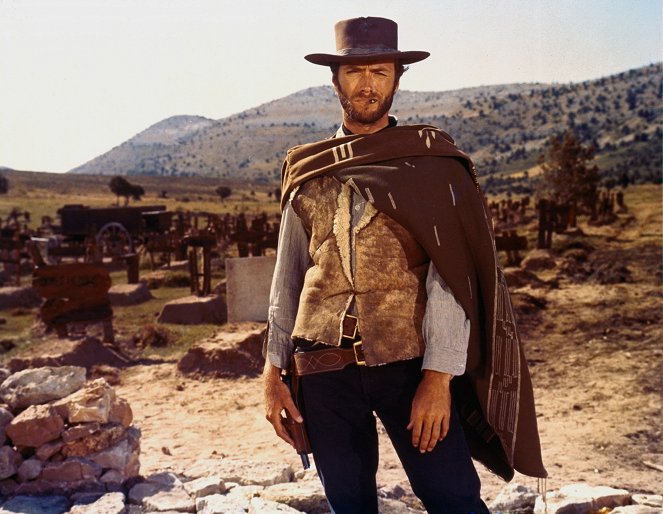
Western TV series
Reruns of older movie westerns failed to satisfy the audience's demand during the tremendous rise of television in the 1950s, leading to the production of a significant number of series, many of which became classics and remained on the screen for many years. The most famous are The Lone Ranger (1949-1957), Cheyenne (1955-1962), Gunsmoke (1955-1975), Maverick (1957-1962), Rawhide (1959-1966), Bonanza (1959-1973) and The Virginian (1962-1971). The peak of this output was 1959, during which American viewers could choose from a total of 26 western series during prime time.
With the advent of colour TV in the 1960s, most of the (standard half-hour) series of the time were gradually replaced by new ones with episodes twice as long. However, as viewers' demands for the type and level of television entertainment changed over time, western serials would be gradually replaced by other genres. In the 1960s and 70s, western shows often took the form of light-hearted stories suitable for the whole family, such as Little House on the Prairie (1974-1983) and The Life and Times of Grizzly Adams (1977-1978), though How the West Was Won (1976-1979) was also popular in its time. The western series Dr. Quinn, Medicine Woman (1993-1998), which depicted events in the American West from the point of view of its protagonist, a female doctor, was a success in the 1990s. After 2000, the most successful TV western series were Deadwood (2004-2006), Hell on Wheels (2011-2016) and Longmire (2012-2017), as well as specifically stylized series that combined western with science fiction, such as Firefly (2002-2003) and Westworld (since 2016).
Bonanza (1959) (series)
Photo © National Broadcasting Company (NBC)
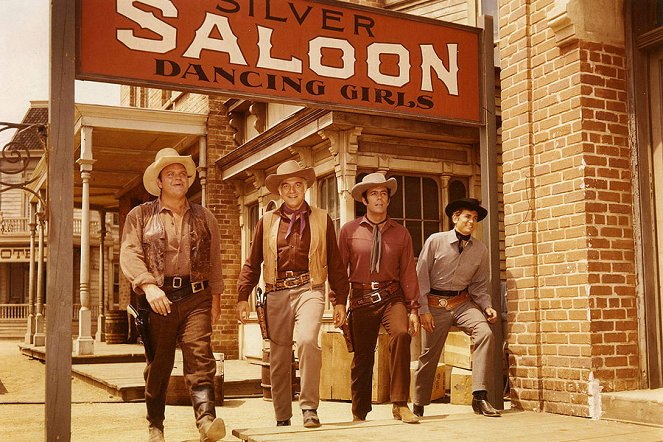
American revisionist westerns
In the 1960s, the American western began to slowly disappear from the silver screen and has since been considered a dying genre by Hollywood studios. It was kept alive by revisionist westerns, also known as anti-westerns or post-westerns, which challenged the traditional ideals, the dual division of good and evil and conventional stereotypes, and broke down earlier genre clichés. For example, it was common before to portray Indians as aggressive red savages out for the blood of white settlers, and there were few films at the time that portrayed Native Americans in a sympathetic and positive way, with Broken Arrow (1950) and Apache (1954) being two examples. Revisionist westerns brought a revolutionary change in this respect - the roles of heroes and villains began to blur, and the concept of the anti-hero emerged. Instead of a black-and-white distinction between good and evil, films began to deal with morally ambiguous acts, and filmmakers often included social critiques of American values.
The category of revisionist westerns includes Sam Peckinpah's Ride the High Country (1962) and The Wild Bunch (1969), Arthur Penn's Little Big Man starring Dustin Hoffman (1970), Ralph Nelson's Soldier Blue (1970), and McCabe & Mrs. Miller (1971). The famous film Butch Cassidy and the Sundance Kid (1969) featured the acting icons of the time Paul Newman and Robert Redford as a duo of sympathetic bank robbers. Paul Newman had already made the anti-westerns The Left Handed Gun (1958) and Hombre (1967), while Robert Redford had played the lead role in the western drama Tell Them Willie Boy Is Here (1969).
Some filmmakers whose careers were largely based on westerns continued to make them, but usually in a way that both transcended the genre and critiqued its conventions. Clint Eastwood took this progressive approach to his second directorial effort, High Plains Drifter (1973), and remained in the western genre in his films The Outlaw Josey Wales (1976) and Pale Rider (1985). In addition, the 1970s saw experimental films made by independent filmmakers who challenged western conventions and came up with distinctive visions of their own. Typical representatives of this trend were the allegorical The Mole by Mexican director Alejandro Jodorowsky (1970) and the bizarre American film Greaser's Palace (1972).
Oscar-winning director Michael Cimino's epic anti-western Heaven's Gate premiered in 1980 and became one of the biggest flops in film history. It was such a scandalous failure that it not only destroyed the director's reputation, but also the entire United Artists studio that financed it. The production of this film was already shrouded in controversy due to constant delays, endless reshoots, quadrupling of the budget, and violence against animals (since then, films have been accompanied by a disclaimer that no animals were harmed in the making of the film and have been monitored for this), and once released in cinemas, it would be condemned by critics and audiences alike. Over the following decades, the film received several reworked versions, the qualities of which were eventually appreciated, but the western genre suffered greatly and was virtually buried throughout the 1980s (with the exception of 1985's Silverado).
Butch Cassidy and the Sundance Kid (1969)
Photo © 20th Century Fox
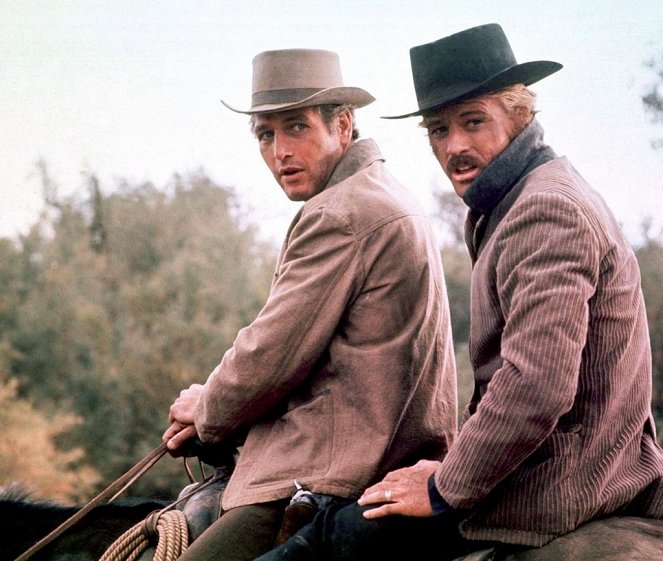
Easterns - Westerns of the East and Winnetou
At the same time that revisionist westerns were being made in America and spaghetti westerns were being made in Italy, the countries of Central and Eastern Europe began to come up with their own response to the genre. These films, called "easterns" (or also "osterns"), fell into two categories. One was set in the American Wild West, but thematically they were fundamentally different and interpreted the conventions of the genre in their own way. The other faithfully adopted the clichés of American westerns, but set them in the unconventional environment of the Caucasian steppes or in other European or Asian parts of the Russian Empire at the time of the Russian Revolution and the ensuing Civil War.
The first category included the Czechoslovak film Lemonade Joe or Horse Opera (1964), which approached western clichés by way of musical parody, or the similarly satirical Soviet film A Man from Boulevard des Capucines (1987), which was a musical comedy, too. The East German The Sons of Great Bear (1966), on the other hand, turned the tendency to portray Indians as negative characters on its head by portraying them sympathetically as an oppressed and exploited group of people striving for their rights, while the villains were clearly members of the U.S. military. The Romanian film The Prophet, Gold and the Transylvanians (1978) told a light-hearted western story about two Romanian brothers who go to America in search of their sibling.
In Germany, the popularity of westerns culminated in a series of films inspired by the works of writer Karl May, featuring Apache tribesman Winnetou and his white friend Old Shatterhand, who were portrayed by actors Pierre Brice and Lex Barker, first in Treasure of Silver Lake (1962), followed by many other films. The first Winnetou (1963) was still fairly faithful to its literary source, while its numerous sequels such as Winnetou: The Red Gentleman (1964) and Winnetou: The Last Shot (1965) were loosely based on May's books. Other films worth mention include Old Shatterhand (1964), The Oil Prince (1965) a The Valley of Death (1968).
The second category of easterns, transferring elements of American westerns to the territory of the Russian Empire, consisted mainly of Soviet films whose heroes were the builders of a new social order, and their opponents were usually Gypsy nomads, Cossack bandits or Turkish Muslims instead of Indians. Typical examples were The Elusive Revengers (1966), The White Sun of the Desert (1970), Dauria (1971) and Nikita Michalkov's directorial debut At Home Among Strangers (1974). The other countries of the former Eastern Bloc often collaborated in the production of the films, with the crew usually consisting of people of various nationalities, and filming usually took place in Yugoslavia or Bulgaria. Several easterns were also made in Hungary, for example, The Wind Blows Under Your Feet (1976) and Wrong-doers (1979).
Winnetou (1963)
Photo © Jadran Film
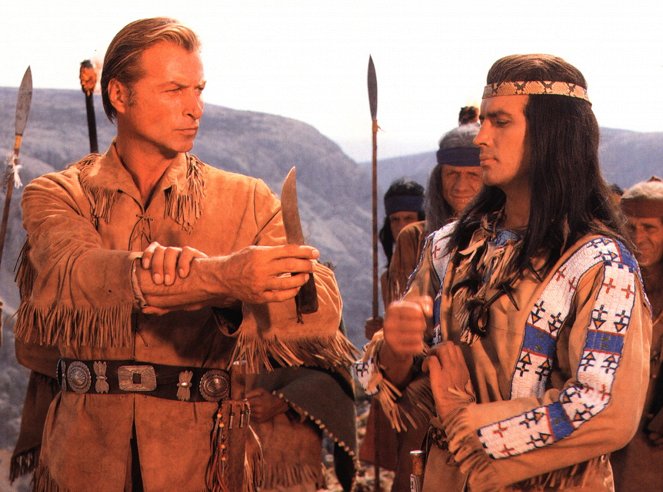
The resurrection of the American western and contemporary neo-westerns
After a hiatus of about a decade, a major breakthrough for the western genre came in 1990 when Kevin Costner succeeded with his anti-western directorial debut Dances with Wolves. Costner's monumental tale of an American soldier who manages to win the trust of an Indian tribe was a huge hit and won seven Academy Awards, including Best Picture and Best Director. Two years later, the same category was dominated by Unforgiven (1992), the pinnacle of Clint Eastwood's western directorial output. This realistic film, in which a group of women pays for a just retribution, turned in a total of four golden statuettes out of twelve nominations. Both films have since been considered major genre milestones, virtually reviving the western in the early 1990s.
Their success was followed in the first half of the 1990s by George P. Cosmatos' Tombstone (1993), starring Kurt Russell and Val Kilmer, and Jim Jarmusch's Dead Man (1995), a poetic independent anti-western starring Johnny Depp. Kevin Costner took on the leading role in Wyatt Earp (1994), which was not successful, and Ang Lee's Ride with the Devil (1999) was a major box office flop. Both filmmakers redeemed themselves later, Costner with his western Open Range (2003) and Ang Lee with the groundbreaking Brokeback Mountain (2005), about two cowboys, played by Jake Gyllenhaal and Heath Ledger, who fall in love.
With the turn of the millennium, neo-westerns began to appear more frequently than before, i.e. films that adopted the form and conventions of classic westerns but set them in contemporary realities. They already existed decades ago, with examples such as The Misfits (1961), the last film with Marilyn Monroe and Clark Gable, and Hud (1963) with Paul Newman. Robert Rodriguez's "Mexican Trilogy", consisting of El Mariachi (1992), Desperado (1995) and Once Upon a Time in Mexico (2003), was a significant representative of the neo-western. After 2000, the number of such films grew - besides the aforementioned Brokeback Mountain, other neo-westerns include Tommy Lee Jones's The Three Burials of Melquiades Estrada (2005), Wim Wenders's Don't Come Knocking (2005), Down in the Valley with Edward Norton and Evan Rachel Wood (2005), and No Country for Old Men (2007), with which the brothers Joel and Ethan Coen succeeded at the Oscars. In later years, Taylor Sheridan was the most successful in adopting the principles of the neo-western in his films Hell or High Water (2016) and Wind River (2017).
In addition, this time also saw the release of the revisionist western The Assassination of Jesse James by the Coward Robert Ford (2007). The Australian The Proposition by John Hillcoat (2005), The Lone Ranger by Gore Verbinski (2013), who had previously made the animated Rango (2011), Quentin Tarantino's Django Unchained (2012) and The Hateful Eight (2015), Bone Tomahawk by S. Craig Zahler (2015), Hostiles by Scott Cooper (2017) and News of the World by Paul Greengrass (2020) have also received strong reviews. There have also been a number of remakes: James Mangold's 3:10 to Yuma (2007) was a remake of the 1957 film of the same name, the Coen Brothers' True Grit (2010) was based on the namesake 1969 film, and The Magnificent Seven received a new version in 2016.
Tombstone (1993)
Photo © Hollywood Pictures
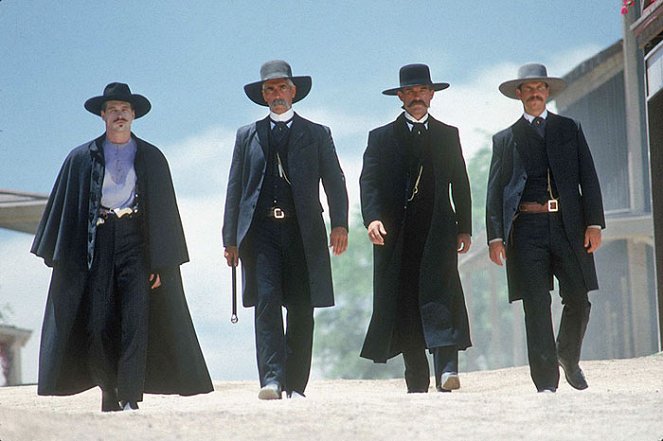
The crossover of westerns into other genres
Over the years there have been westerns that adopted elements taken from other genres, creating entirely new sub-genres that were divided into several branches. One of the most common was the comedy western, which fully embraced the setting, characters, motifs and stylization of westerns, but was comedic, satirical or parodic. Charles Chaplin's slapstick The Gold Rush (1925) was already based on a gold-mining theme, and strong western elements were also present in Laurel and Hardy's comedy Way Out West (1937). Other comedy westerns include North to Alaska (1960), Support Your Local Sheriff! (1968), and Mel Brooks’s parody Blazing Saddles (1974), as well as newer ones such as Maverick with Mel Gibson and Jodie Foster (1994), Shanghai Noon with Jackie Chan and Owen Wilson (2000) and A Million Ways to Die in the West directed by Seth MacFarlane (2014).
Some westerns, on the other hand, took on certain aspects of science fiction, fantasy or horror. In The Valley of Gwangi (1969), cowboys and wranglers battled dinosaurs; Westworld (1973), which later was adapted into a TV series of the same name, was set in a western theme park full of robots, Back to the Future Part III (1990) took the heroes from the present to the Wild West by means of a time machine, and Cowboys & Aliens (2011) introduced an alien plot into the cowboys and Indians. Some westerns were not set on Earth, but in other parts of the universe, for example, Cowboy Bebop (1998-1999) or the previously mentioned Firefly (2002-2003) were influenced by western elements. The classic westerns have also inspired, to some extent, the Star Wars and Star Trek science fiction franchises.
In contrast, horror elements abounded films such as Billy the Kid versus Dracula (1966), Near Dark (1987) and The Wind (2018), while Wild Wild West (1999) was strongly intertwined with a steampunk style. The comic book film Jonah Hex (2010) linked the western with superhero themes, while the Stephen King-inspired The Dark Tower (2017) enriched the actions of western characters with a rich fantasy mythology. The musical western Zachariah (1971) built its plot around rock band performances, while other films such as Calamity Jane (1953) and Paint Your Wagon (1969) even managed to combine a western with musical.
Maverick (1994)
Photo © Warner Bros. Pictures

Westerns from other countries
From the 1930s to the late 1960s, the "charro westerns" (sometimes also called "chili westerns") were popular in Mexico, often starring famous figures of the music scene, whose heroes, called charros (horsemen), differed in many ways from American cowboys. Popular actors of the time included Pedro Infante (Little Love of My Life, 1952) and Antonio Aguilar (Juan Colorado, 1966). The term "ramen western", on the other hand, refers to westerns shot in Asia. Typical examples are the South Korean film The Good, the Bad, the Weird (2008), the Thai western comedy Tears of the Black Tiger (2000), the Japanese Sukiyaki Western Django (2007), and the Chinese Let the Bullets Fly (2010).
Kalam Vellum (1970), on the other hand, was the first western produced in India. It was followed by, among others, Mosagalaku Mosagaadu (1971) and Jakamma (1972), which were modelled after classic American westerns, while, for example Thai Meethu Sathiyam (1978) and The Valley (1990) were influenced by spaghetti westerns. Quick Gun Murugun (2009) was an Indian comedy poking fun at western films, and the western Irumbukkottai Murattu Singam (2010), which paid homage to American stars John Wayne and Clint Eastwood, was also comedic.
Australian westerns, usually set in the Australian outback, are represented by The Kangaroo Kid (1950), The Man from Snowy River (1982), Quinley Down Under (1990), the aforementioned The Proposition (2005) and Sweet Country (2017), among others. In Europe, in addition to spaghetti westerns and easterns, westerns were also filmed in Great Britain (Eagle's Wing, 1979), France (Another Man, Another Chance, 1977) and Spain (The Naked Spur, 1967), while the Greek western Blood on the Land (1965) was even nominated for an Oscar in 1966 in the Best Non-English Language Film category. Recent European westerns include the Danish co-production The Salvation (2014), the Austrian The Dark Valley (2014) and the star-studded Dutch film Brimstone (2016).
Filmmaniak
Best westerns
Once Upon a Time in the West (1968) |
The Good, the Bad and the Ugly (1966) |
The Magnificent Seven (1960) |
Butch Cassidy and the Sundance Kid (1969) |
Dances with Wolves (1990) |
Django Unchained (2012) |
For a Few Dollars More (1965) |
Back to the Future Part III (1990) |
The Treasure of the Silver Lake (1962) |
Little Big Man (1970) |
| All the best westerns |